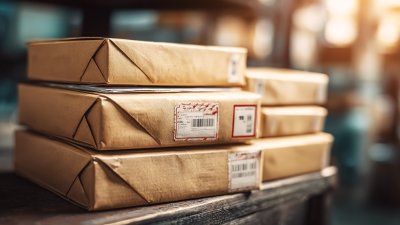
The Ultimate Guide to Sustainable Shipping Packaging: Eco-Friendly Solutions for Your Business
In today's rapidly evolving market, businesses are increasingly recognizing the importance of sustainable practices, particularly in the realm of shipping packaging. As consumers become more environmentally conscious, the demand for eco-friendly shipping solutions continues to rise. According to Dr. Emily Carter, a leading expert in sustainable packaging, "The future of shipping packaging lies in our ability to innovate while keeping environmental responsibility at the forefront of our choices." This sentiment underscores the necessity for companies to adopt greener strategies that not only minimize their ecological footprint but also appeal to a growing demographic of eco-aware customers.

Navigating the world of sustainable shipping packaging involves making informed decisions about materials, designs, and sourcing practices. The transition to eco-friendly alternatives is not merely a trend but a vital step towards a sustainable future. Businesses that proactively embrace these practices can differentiate themselves in a competitive marketplace while contributing positively to the environment. In this guide, we will explore various sustainable shipping packaging solutions that can be tailored to meet the unique needs of your business, ensuring that you remain ahead of the curve in this essential aspect of logistics.
Innovative Eco-Friendly Materials: Bioplastics and Recycled Content Packaging Solutions
In the evolving landscape of packaging, sustainable solutions have become a cornerstone for businesses aiming to reduce their ecological footprint. The integration of innovative eco-friendly materials, such as bioplastics and recycled content, plays a crucial role in this transformation. With rising consumer awareness and regulatory pressures to phase out single-use plastics, companies are increasingly exploring alternatives that align with environmental goals. The global sustainable packaging market is poised for growth, projected to reach USD 557.65 billion by 2034, highlighting the significant demand for thoughtful packaging solutions.
Tips: When considering bioplastics, assess their source and biodegradability, ensuring they contribute positively to sustainability. For recycled content packaging, verify the percentage of post-consumer material used, as this directly impacts waste reduction. Engaging suppliers who prioritize sustainability can further enhance your business's eco-friendly image.
As sectors like food and cosmetics prioritize sustainable practices, businesses can benefit from ongoing innovations in this arena. Trends indicate a shift towards compostable and recyclable options that not only address environmental concerns but also resonate with eco-conscious consumers. Fostering a culture of sustainability within your operations can lead to cost savings and improved brand loyalty, reinforcing the integral role of green packaging in 21st-century commerce.
Reducing Carbon Footprint: The Impact of Sustainable Packaging on Logistics Efficiency
Sustainable packaging is more than just a trend; it's a critical component in enhancing logistics efficiency and reducing a company's carbon footprint. According to a 2020 study from the Ellen MacArthur Foundation, transitioning to sustainable packaging could reduce global carbon emissions by up to 68 million metric tons annually. This reduction is significant, as logistics and packaging contribute to approximately 29% of global greenhouse gas emissions, emphasizing the need for businesses to adopt eco-friendly solutions.
Implementing sustainable packaging materials, such as biodegradable plastics and recycled materials, not only minimizes waste but also optimizes shipping processes. A report by McKinsey found that companies transitioning to eco-friendly packaging solutions have seen a 20% reduction in logistics costs. By utilizing lightweight and compact packaging, businesses can improve fuel efficiency and lower shipping expenses, creating a win-win scenario for both the environment and their bottom line. Sustainable packaging is thus integral to enhancing logistics efficiency while aligning with growing consumer demand for environmentally responsible practices.
Cost-Benefit Analysis: Long-Term Savings through Sustainable Shipping Solutions
Sustainable shipping packaging is not only a responsible choice but also a financially savvy one. According to a 2021 report by Smithers Pira, the sustainable packaging market is anticipated to reach $500 billion by 2024, highlighting a growing consumer preference for eco-friendly options. Businesses that adopt sustainable shipping practices can benefit from a decrease in material costs, as many sustainable materials, such as corrugated cardboard and biodegradable plastics, often have lower production costs in the long term. Additionally, companies can save on waste management expenses by reducing the amount of non-recyclable materials they use.
Tip: Evaluate your current packaging strategy and identify areas where you can switch to sustainable materials. Transitioning to biodegradable packing peanuts or recyclable paper can significantly reduce waste and associated costs.
Moreover, investing in sustainable shipping packaging can position your business as an eco-conscious leader in your industry. A study by the Nielsen Group indicates that 73% of consumers are willing to pay more for sustainable products. By highlighting your commitment to sustainability, you can attract new customers and build brand loyalty.
Tip: Promote your sustainable practices through marketing campaigns to connect with environmentally-conscious consumers. This not only boosts sales but may also lead to reduced pricing from suppliers who prioritize sustainable practices.
Consumer Demand Trends: How Eco-Conscious Packaging Drives Customer Loyalty
As consumer awareness about environmental issues rises, the demand for eco-conscious packaging has become a significant driver of customer loyalty for businesses. According to a 2020 report by McKinsey & Company, nearly 60% of consumers are willing to change their shopping habits to reduce environmental impact, highlighting the growing importance of sustainability in buying decisions. This shift is particularly pronounced among younger consumers; a study by Nielsen notes that 73% of millennials are willing to pay more for sustainable products, showcasing a lucrative market for brands that prioritize eco-friendly packaging solutions.
In response to these trends, businesses are increasingly adopting sustainable packaging practices to enhance their brand image and meet consumer expectations. The 2021 Global Sustainable Packaging Market report suggests that the sustainable packaging market is expected to reach $475 billion by 2026, driven by both regulatory pressures and consumer preference. Companies that utilize recyclable, biodegradable, or reusable packaging not only attract eco-conscious consumers but also position themselves as leaders in corporate responsibility, leading to stronger customer relationships and increased brand loyalty. As such, integrating sustainable packaging is not merely an ethical choice but a strategic business move that aligns with consumer values.
The Impact of Eco-Conscious Packaging on Customer Loyalty
Regulatory Compliance: Navigating the Legal Landscape of Sustainable Packaging Requirements
Navigating the legal landscape of sustainable packaging requirements is crucial for businesses aiming to adopt eco-friendly practices. Regulatory compliance not only helps avoid fines but also enhances your brand's reputation. Many governments worldwide are introducing stricter mandates on packaging materials and waste management. It's essential to stay informed about local laws and international treaties that can affect your packaging choices. Regularly consulting legal experts in environmental law can ensure your business adapts swiftly to these evolving regulations.
**Tips**: Begin by conducting a compliance audit of your current packaging materials. Identify any areas where your practices fall short of regulatory standards. This proactive approach allows you to adjust before sanctions come into play. Additionally, consider attending industry workshops or webinars focused on sustainable packaging laws to gain insights and share experiences with peers.
Moreover, collaborating with suppliers who prioritize sustainability can ease compliance challenges. Ensure that your partners understand and adhere to the necessary regulations, as their practices can impact your own compliance status. Building a transparent supply chain will not only simplify legal navigation but also reflect your commitment to sustainability to consumers.
The Ultimate Guide to Sustainable Shipping Packaging: Eco-Friendly Solutions for Your Business
| Packaging Type | Material | Recyclability | Biodegradability | Regulatory Compliance |
|---|---|---|---|---|
| Kraft Paper Box | Recycled Paper | Yes | Yes | FDA, EU Regulations |
| Bioplastic Mailers | PLA (Polylactic Acid) | Yes | Yes | ASTM D6400, EN 13432 |
| Mushroom Packaging | Mycelium | Yes | Yes | ISO 14021 |
| Cardboard Inserts | Recycled Cardboard | Yes | Yes | EPA Guidelines |
| Plant-Based Bubble Wrap | Biodegradable Materials | Yes | Yes | ASTM D6868 |
Related Posts
-

How to Choose the Right Shipping Envelopes for Your Business Growth and Cost Efficiency
-

5 Essential Tips for Choosing Sustainable Printed Bags: Boost Your Brand's Eco-Friendly Image
-

How to Identify Top Suppliers for Best Large Poly Mailers: A Comprehensive Guide with Industry Insights
-

Addressing the Challenges of Poly Mailer Bags in E-commerce: Industry Insights and Solutions
-

How to Choose the Right Shipping Envelopes for Your Business Needs
-

Unveiling the Best Silver Bag: Innovative Approaches to Elevate Your Fashion Game



